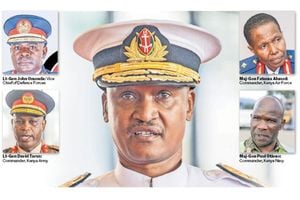Lari Massacre still rekindles bitterness

Photo/ERIC WAINAINA
Mr Samuel Waihenya, 30, the founder of Lari Peace Museum shows a collection of the famous Lari Massacre photos with the names of victims. The group has initiated peace clubs in schools training colleges to rebuild inter-ethnic trust, following the post election violence.
The divide between descendants of Mau Mau fighters and colonial government loyalists has been fierce.
Fifty-eight years on, the Lari Massacre still divides the people who still hold bitterness and accuse each other of betrayal.
Some have even opposed inter-marriage between the two sides, yet they are from the same ethic group and live in the same area.
Concerned about the unending acrimony, a group of youth have begun a journey they hope will cut the chain of hatred between the two groups, through The Lari Memorial Peace Museum.
The group based at Kimende shopping centre introduced a dialogue board, which comprises elders from the Mau Mau fighters and Ex-home guards, who have been preaching forgiveness in schools and social places.
Vendetta culture
Mr Samuel Waihenya, 30, the group founder said they seek to help overcome bitterness, loss of life and humiliation that many have suffered, without a culture of vendetta and revenge taking over their minds.
When he started the museum a few years ago, his mission was to help bring healing between descendants of the Mau Mau veterans and colonial government loyalists in Lari, who have remained divided following the massacre, where tens of people died.
As a result of the massacre, enmity, hatred and suspicion was rooted in the community. Nearly 60 years later, the wounds seem fresh, and are being handed over from one generation to the other, Mr Waihenya said.
“We seek to promote forgiveness, wise leadership, sensitive and generous love for peace, always remembering that a tooth for a tooth and an eye for an eye leaves us all the worse,” he told the Nation.
The massacre took place on March 26, 1953, when the Mau Mau attacked loyalist home guard families, killing about 74 and wounding 50.
The museum in Kimende has photographs of the massacre and the names of the victims.
Mr Waihenya said the exhibit seeks to tell a story of Lari’s dark and painful past, hoping to act as a mirror for a hopeful future.
It’s not been easy to convince people who watched their husbands and relatives killed in cold blood forgive the perpetrators.
But gradually, some people have forgiven each other through reconciliation between the veterans and loyalists.
They have also received visitors from outside Kenya, and recalls one by the Nguru of northern Uganda, led by their paramount chief David Achana.
Mr Waihenya trained on peace building at Mennonite University in Virginia, USA and Mindole Ecumenical Foundation in Kitwe, Zambia.
Following the post election mayhem which claimed 1,300 lives and displaced more than 350, 000 people, the group extended its programmes by holding peace prayers cum-rallies in chaos hot spots in five provinces.
They have met elders from 23 communities and plan to bring more on board. At their Kimende museum, is a map of Kenya formed using beads.
Coloured circular beads represent the tribes of Kenya as a symbol of healing the post-election violence wounds.
Elders who placed beads there signify that they have accepted to bury ethnic differences. They have also toured primary and secondary schools in six provinces.
“To have real peace in the world, we must begin with children. These were Mahatma Gandhi’s words,” says Waihenya.
The youths have peace clubs in schools-primary, secondary and teacher training colleges in Central, Nyanza, Western, Rift-Valley and Eastern Provinces.
The Mennonite Centre sponsored group has been donating eight Internet computers per school with an active peace club or in well established community centres.
Mr Waihenya said that this helps communities in accessing information and promoting social networking across ethnic divides in Kenya via the Internet.
They have peace libraries in schools, and written a peace education manual. This May, they held a cycling torch from Kisumu via Kakamega, Eldoret, Nakuru and Naivasha back to Lari.
The participants are Kikuyus, Kalenjins, and Luos which were highly affected by the violence of 2008.




